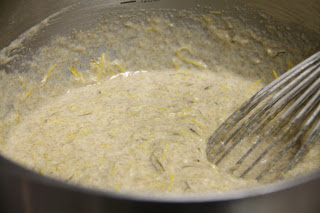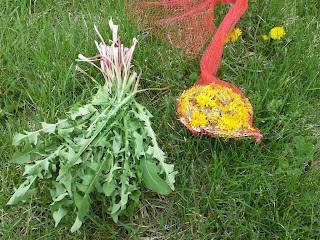 |
| Take your time, little bee. After you're done, we'll take the flower for our own food! This picture also explains why herbicides shouldn't be sprayed on dandelions. |
For a long time, our favorite way to ingest all this dandelion-based nutrition was via dandelion pancakes because the flower petals were the only thing that wasn't too bitter for us to eat. But then we read an article by John Kallas that explained everything. It was as if the clouds had parted and a multitude of angels had delivered unto us a great truth (that is to say, thanks, Dr. Kallas). Basically, fresh dandelions are so gut-wrenchingly bitter because they contain a class of compounds known as sesquiterpene lactones, such as the taraxinic acid derivative below (hence the dandelion's genus, taraxacum).
 |
| 11, 13-dihydrotaraxinic acid-1´O-ß-D-glucopyranoside, one of the main reasons fresh dandelion greens don't taste good. |
Fortunately, these compounds have an appreciable solubility in water, so it's possible to extract them by soaking the dandelions. As Kallas notes, many recipes call for boiling the dandelion greens to make them less bitter, but we've had good luck with just soaking them in clean room-temperature water for 15 minutes or more (try a ratio of about half a cup of chopped greens to four cups water). If the greens are still bitter after 20 minutes, change the water and soak again. Since the water will contain the extracted compounds, it will taste slightly bitter. However, the compounds will be very dilute, and the water may even seem drinkable as a sort of bitter tonic. (It does to us!) In the olden days, they used to say bitter tonics were good for the blood, or they'd put hair on your chest, or something like that. Andyway. since it's just about the right time of year to be picking the first dandelions, we thought we'd put together a dandelion-themed meal to celebrate the arrival of spring! We've got our favorite dandelion pancakes, accompanied by sautéed dandelion greens, and complimented with some other side dishes. This is going to be good!
 |
| Back at the Lab, we've rinsed the greens and got them looking nice for their photo shoot. |
 |
| Next we chopped 'em up into bite-size pieces. We've got about a cup of chopped greens here. |
 |
| In the meantime, we started extracting the yellow petals from the flower heads. The technique we found to work the best is to get a thumbnail between the outer green and inner yellow parts, work down to the base of the flower, then kind of dig across to get the petals out. (Edit: actually, we found a better way the next spring.) This is the most tedious part of the whole process. We should invent a dandelion petal separator to make it easier. There's probably a huge market for that sort of thing. |
 |
| A perfect scrape--good job, Katie! |
 |
| Looks like a successful operation. The 100 flowers yielded about a cup of petals. |
 |
| The process from here is pretty similar to making blueberry or chocolate chip pancakes, except instead of adding blueberries or chocolate chips, add dandelion petals. |
 |
| Make up your favorite pancake batter (one sample recipe below), then mix in the dandelion petals. Looks nice and hearty! |
 |
| We drop the batter by the half-cupful onto a hot griddle or frying pan. This particular specimen is lookin' good! |
 |
| Mmmmm...roasted sweet potatoes. |
The recipes:
Dandelion Pancakes:
2 Eggs
2-1/3 cups milk
1/2 cup sugar
1 tablespoon lemon juice
1 teaspoon vanilla
1 teaspoon salt
3 cups whole wheat flour
2 teaspoons baking soda
1 cup dandelion petals
Whisk together eggs, milk, sugar, lemon juice, and vanilla. Add salt, flour, and baking soda, stir until combined. Fold in dandelion petals, drop by half-cupful onto hot griddle or frying pan, fry until golden brown on both sides, flipping once. This recipe makes very thick pancakes--for thinner cakes increase milk or decrease flour.
Sautéed Dandelion Greens:
~1/2 pound dandelion greens
water for soaking
one scrawny morel mushroom (optional)
salt, pepper, basil to taste
Pick fresh dandelion greens, rinse, chop, and soak in cold-lukewarm water for at least 20 minutes. Use a ratio of 1/2 cup dandelion greens to 4 cups soak water. If the greens are still too bitter after 20 minutes soaking, change water and soak another 20 minutes. Drain greens and sauté in butter or olive oil, seasoning to taste with salt, pepper, and basil. Serve hot, with co-sautéed mushrooms if desired.
Roasted Sweet Potatoes:
3-4 medium sweet potatoes, trimmed of bad spots and diced
1/4 cup olive oil
1/2 teaspoon each salt, pepper, dried basil, dried rosemary, onion powder, garlic powder
In a large bowl, toss diced potatoes with oil and seasonings. Turn out onto cookie sheet, bake at 425 °F for 25-35 minutes, or until taters are soft enough to eat.
Do you have a favorite recipe for dandelions? What are some of your favorite spring greens to eat this time of year? Tell us about it in the comments section below!







No comments:
Post a Comment